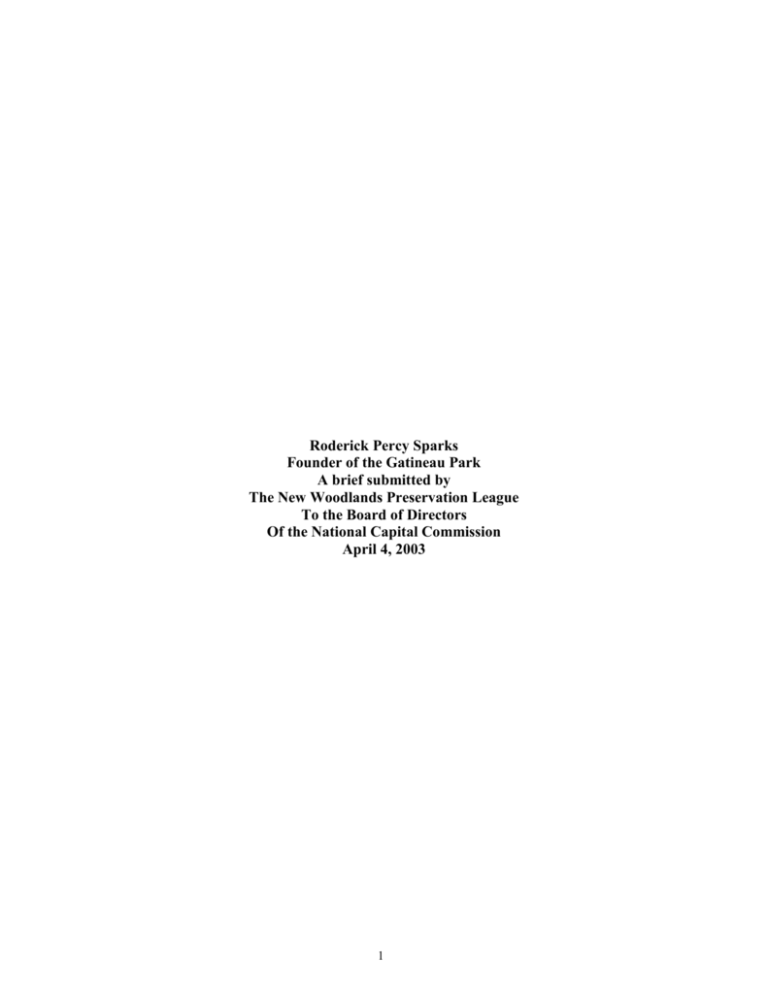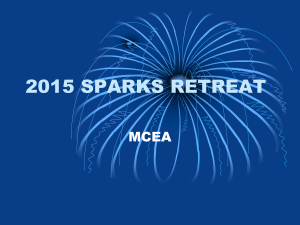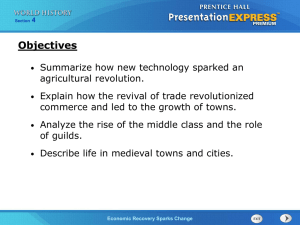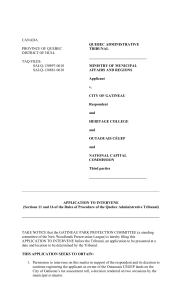Memory Suppressed: Roderick Percy Sparks
advertisement

Roderick Percy Sparks Founder of the Gatineau Park A brief submitted by The New Woodlands Preservation League To the Board of Directors Of the National Capital Commission April 4, 2003 1 Man’s struggle against power, is the struggle of memory against forgetting Milan Kundera Though the official history written by the National Capital Commission attempts to portray William Lyon Mackenzie King and Jacques Gréber as creators of the Gatineau Park, a more complete and accurate study of history reveals that Roderick Percy Sparks was the prime mover behind this initiative. For reasons we don’t fully comprehend – though we have some theories – the key contribution made by Roderick Percy Sparks to the creation of the Gatineau Park has been erased from all official and most unofficial histories of the park and his memory has been all but forgotten. Before demonstrating that Percy Sparks was the leading proponent, architect and founder of the Gatineau Park, it’s useful to look at what the National Capital Commission says in this regard. For brevity’s sake, we’ll only sketch the broad outline of their version. Most brochures, booklets and more serious works on the Gatineau Park basically tell us that the responsibility for the park goes back to plans for the nation’s capital written by Messrs. Todd, Holt, Cauchon and Gréber, in 1903, 1915,1921 and 1950, respectively. What we aren’t told is that these reports didn’t provide blueprints for a park, nor action plans for setting it up. In some rare instances we are told that various citizens groups, including the Ottawa Ski Club and the Federal Woodlands Preservation League, were worried about excessive logging in the Gatineau Hills in the mid thirties, and decided to lobby the federal government for the creation of a national park. No record of their activities nor specific accomplishments are provided, however. We are then, rightly, informed that William Lyon Mackenzie King played an important role in the park’s creation, but aren’t told that he essentially rubber stamped the various proposals presented to him by the park’s architects in the Woodlands Preservation League. In my view, the most monumental blunder committed by the NCC in this regard is that it associates the park’s creation to French urban planner Jacques Gréber. No matter that the park was created in 1938, and that the first mention Gréber made of it was in his 1950 report, NCC officials continue to this day to make that false and misleading claim. For instance Gatineau Park historian, Dennis Messier recently wrote a book entitled Mackenzie King Estate, which contains a chapter on the creation of the Gatineau Park. In it, we find out that Gréber’s services as an urban planner were retained by King in 1936, that his work was delayed by the war, and that it was only in 1949 that he submitted recommendations to expand the park, which “included a threefold mandate: [for the] conservation of the Park’s cultural and natural heritage, development of Park interpretation services and construction of a recreation area” (p.20). Note that Messier never tells us who created the park, in a chapter titled creation of the park. All he says is that Gréber had something to do with its expansion. The confusion, to put it mildly, is utter and complete. First, Gréber came to Ottawa in 1936, not to draft proposals for the Gatineau Park, but “to study the planning of the 2 administrative centre of the city” (Gréber Plan, p. 1). Second, while the 1950 Gréber Plan said some nice things about the Gatineau Park, and the need for its expansion, its comments were only very general, and the report can in no way be considered a blueprint or master plan for the park. Third, credit for recommending a mandate for the park belongs more properly to the Federal Woodlands Preservation League, and to the Advisory Committee on Gatineau Park, both of which were chaired by Percy Sparks. Finally, putting to rest the notion that Jacques Gréber was a leading proponent for the creation of the park is a letter sent to Mackenzie King on a June 29, 1937 by Federal Woodlands Preservation League Secretary, Duncan MacTavish. The letter informs the Prime Minister that members of the league would like meet with Mr. Gréber to give him their views on the need for creating the Gatineau Park as part of an overall national capital plan. Although Messier and the NCC appear confused about the history of the Gatineau Park, Gréber, in his report, gives credit where it is due: “The Advisory Committee to the Federal District Commission on Gatineau Park, of which Mr. P. Sparks is Chairman […] are in full and enthusiastic accord with us on the possibilities of this wooded reserve, and have, in large measure, inspired our recommendations relative to practical developments of this providential asset of the Capital Region” (p. 293). As well, commenting on the study and development of the Gatineau Park, Gréber said that the Advisory Committee “had already submitted a most complete and interesting report in which all aspects of the development and life in the park are dealt with.” (p. 248). This likely refers to the 1949 Report of the Advisory Committee on the Gatineau Park – all traces of which seem to have disappeared. The evidence, which includes newspaper clippings and correspondence on the Federal Woodlands Preservation League and the Gatineau Park irrefutably supports the claim that Percy Sparks played the leading role in the park’s creation. He did so by garnering public support, lobbying the government, and drafting the first master plans. As evidence that Sparks was closely involved with the park’s creation, two newspaper articles from the fifties offer compelling testimonies. Accordingly, the Ottawa Journal of May 12, 1955, said that “Mr. Sparks and his associates are generally credited with ‘selling’ the late Prime Minister Mackenzie King the idea of setting aside a national recreation area on the outskirts of Canada’s capital.” As well, on March 30, 1959 the same paper credited Sparks with being the “father of the Gatineau Park,” adding that, as chairman of the Federal Woodlands Preservation League from 1937 to 1947, he “brought about the first purchase by the Dominion government of what is now […] the Gatineau Park.” However, the actual proof that Sparks is the founder of the park is found in six key documents, most of which he wrote – one was commissioned by the government at his instigation – in the context of his activities as a member of the Federal Woodlands Preservation League and chairman of the Advisory Committee on the Gatineau Park. But before examining the documents, I’ll briefly mention the league. Created by group of citizens worried about the massive logging near Meech Lake and Kingsmere, the league began lobbying the federal government in 1934 to take action on preserving the woodlands near Ottawa and was the main group responsible for bringing about creation of the park. The list of its patrons and members reads like a Who’s Who of the day: while it operated between 1934 3 and 1947, members of the league included, Governors General Bessborough, Tweedsmuir and Athlone, Sir Robert Borden, Arthur Meighen, R.B. Bennett, Mackenzie King, Harry Baldwin, Percy Sparks, Duncan MacTavish, Ernest Lapointe, Ambrose O’Brien, etc. Arguably, the most important document leading to the creation of the Gatineau Park is the 1935 Lower Gatineau Woodlands Survey. As vice-president and chairman of the research committee of the Federal Woodlands Preservation League, Sparks did the preliminary background study and persuaded the Bennett government to commission the survey in a letter of April 3, 1935 to Interior Minister T. G. Murphy. The purpose of the Survey, which was tabled on December 12, 1935, was to examine the “effects of wood cutting operations and of fires on the aesthetic value of the forests”(W.M. Robertson, Interim Report, October 18, 1935) in the lower Gatineau valley and to recommend remedial measures. The Survey drew up a history of forest fires and logging activities throughout the 19th and early 20th centuries, examined the excessive logging brought about by the depression, and dealt with other questions such as land ownership, rate of growth for timber, yield per acre, etc. It concluded that nearly 40 percent of the area surveyed had been “completely or partially cut” in the previous 20 years (p. 9). And though surveyors determined that, from a forestry standpoint, the logging had not been excessive, they noted that it did have a seriously detrimental effect in terms of scenic values and for those wishing a more intimate association with the woods – clearly important factors when considering the creation of a national park. In any event, the Lower Gatineau Woodlands Survey outlined eight options to control excessive cutting in the area, including public education, land purchase and the creation of a national park. Of the alternatives discussed, the Survey recommended the land purchase method as the preferred course of action. It would allow the government to acquire the most important areas and purchase additional land as funds and time allowed. The national park method was downplayed, because the size of the area studied – about 16,000 acres – was too small and that the scheme would be too expensive and complicated in the short term. However, even if the Survey was tabled in late 1935, the government didn’t start purchasing land until 1938. In my opinion, two factors explain this situation: first, a new government was elected in late 1935, with Mackenzie King’s Liberals defeating the Bennett Conservatives; second, King seemed very hesitant and cautious in this regard, since he’d been wrongly accused in 1927 of wanting to build a national parkway to ease access to his summer residence at Kingsmere. Moreover, King’s journal entry of December 20, 1937 clearly indicates that he continued to fear criticism in this regard and that he needed prodding to take action. The entry relates a conversation King had with Finance Minister Charles Dunning concerning the creation of a national park in the Gatineau Hills: “He wanted to know what I wished to have done. I told him that the matter had stood over last year because of my feeling that people might think I was seeking to improve property around Kingsmere. I have come to the conclusion this year that I should not let possible misunderstanding of my ownership at Kingsmere stand in the way of a much-needed preservation of the forest. I told him I wished them to go ahead with the 4 work, though personally it meant less in the way of seclusion for myself on the way to and from Kingsmere to have even the Meach Lake district open to tourists. I believe that we owe it to the Capital of Canada to save that part of its environment. I think he will agree to the $100,000 being appropriated for that purpose.” So by late 1937, Percy Sparks comes back into the picture to stiffen, as it were, King’s resolve in this regard. On October 9, 1937, Sparks was elected president of the Federal Woodlands Preservation League to replace Harry Baldwin. And, on December 13, 1937, Sparks sends a memorandum to King’s office concerning the recent activities of the league. This is the second key document concerning the creation of the Gatineau Park written by Sparks. In it, he informs the Prime Minister’s office that he has met with Finance Minister Charles Dunning concerning what action might be taken in the upcoming session of Parliament with respect to the creation of the park. The memorandum outlined the number of acres to be acquired and their cost, proposed public information and funding schemes, and discussed the speech that Sparks intended to give on this issue at the Chateau Laurier on January 18, 1938. This document is clearly an attempt to mobilize the government to action. Considering King’s prior hesitation and that the first $100,000 appropriation to purchase land for the park was voted in Parliament on June 29, 1938, it certainly appears to have been key to persuading the government to take action. In any event, it provides compelling evidence that Percy Sparks was managing the process that would lead to the park’s creation. Land purchases for the Gatineau Park began in 1938, and continued to 1941, by which time 14, 553 acres had been acquired. However, the war put a stop to land acquisitions and to the activities of the Federal Woodlands Preservation League. By 1945, the League resumed its activities by pressing the government to continue expanding and developing the park. Though the park had been created in 1938, it remained without shape or direction. To solve the problem, Sparks wrote what is in essence the mother of all Gatineau Park master plans, i.e., the Memorandum on the Enlargement and Development of the Gatineau Park, which was submitted to the Federal District Commission on October 9, 1945. The document recommended that the park’s size be increased to at least 50,000 acres, provided a funding scheme for the purchase of land, and recommended the building of a parkway and recreation facilities. Though many of its proposals may seem a little naive to us today, they nonetheless broke new ground and provided a framework for discussion. In any event, the key parts of this memorandum are its proposals to expand the park and build a parkway, both of which were later implemented. The next document written by Sparks on this issue, the fourth one, is the Memorandum to the Senate Committee on Tourist Traffic, which was submitted on May 27, 1946. As did the 1945 memorandum to the FDC, the document recommended that the park be increased to 50,000 acres, proposed a funding scheme for the purchase of land, and outlined the need to build a parkway and public facilities. It’s important to note at this point that Sparks wrote at least two other key documents concerning the Gatineau Park, namely the 1947 Federal Woodlands Preservation League Memorandum to the Federal District Commission, and the 1949 Report of the Advisory 5 Committee on the Gatineau Park. Unfortunately, however, we have thus far been unable to locate them. By 1947, Sparks’ dedication and pioneering efforts with respect to the park were officially recognized by the Federal District Commission, which appointed him chairman of the Advisory Committee on the Gatineau Park. The committee was asked to prepare a Report on the Master Plan for the Development of Gatineau Park, which it submitted in 1952. Written by Percy Sparks, this document provided explicit recommendations for building an administrative headquarters, parkways, trails, beaches, campsites, etc., and was in essence the mother of all official Gatineau Park master plans. It said, in part, quoting from the 1949 Advisory Committee Report: “‘The prime objective of this plan should be to retain throughout the main area of the park the atmosphere of the Canadian woods and to preserve for all time the natural beauty of the lakes and wooded hills as an inspiration to all those who can enjoy them, whether residents of the surrounding district or visitors from other parts of Canada or foreign lands. As part of the National Capital and thus the possession of all the people of Canada, this park should be developed in a manner in which all Canadians can take pride. While this park will serve a useful purpose as a place of recreation, bringing physical benefits, its greater purpose lies in its possibilities as a spiritual and moral force in the lives of those who visit it’”(p. 4). Though it provided the first comprehensive blueprint for the park, this plan also lay bare conflicting visions about the role that private property would play within the park. Appendix B of the report featured arguments for and against the existence of private property. Sparks presented the position against private property – a position supported by the majority of the Advisory Committee – while the case for it was argued by J.J. Connelly, Herbert Marshall and General E.L.M. Burns. The clash of visions over whether private property should be allowed within the park came to a head in the early fifties in an exchange between Sparks and FDC chairman, MajorGeneral Howard Kennedy. A summary of this exchange is found in Sparks 1955 Memorandum to the Joint Committee of the Senate and House of Commons on the Federal District Commission. This was the sixth and final document which establishes Sparks preponderant role in the park’s development. In it, Sparks urged the government to obtain all lands within the park either by direct purchase or expropriation. He also explained that certain influential people – including Major General Kennedy, who owned a cottage on Kingsmere Lake – were holding up the development of the park for selfish reasons. Ironically, as Sparks noted, Major General Kennedy was an advocate of expropriation of properties to develop the National Capital everywhere but in the Gatineau Park. A clear conflict of interest, given his personal involvement and position as Federal District Commission Chairman. Sparks also charged that the lack of an adequate development policy and the building of a parkway through land not yet acquired by the government was inflating property values and turning the southern edge of the park into a paradise for speculators. Though the evidence presented above clearly establishes that Percy Sparks was the 6 leading architect and force behind the Gatineau Park’s creation, NCC officials have failed to acknowledge this basic truth, and have significantly contributed to erasing all memory of this man and his work, either through sloppy record keeping, negligence or plain ignorance. In fact, by the summer of 2001, the NCC had decided to demolish Sparks’ former home – before fire destroyed it under mysterious circumstances1. The refusal to acknowledge Sparks’ role, and willingness to obliterate his memory may have another explanation. The Gatineau Park’s historical interpreter, Dennis Messier, told our League’s secretary, Mr. Jean-Paul Murray during a phone conversation on February 11, 2002 that officially recognizing Sparks’ contribution might upset private property owners at Meech Lake. The reason for this seems attributable to Sparks’ conviction that the Gatineau Park should be a national park, and that private property should not be allowed within it. The historical record clearly shows that no other individual had as much influence on making the park a reality. Yet Sparks remains completely unrecognized by those NCC officials who are responsible for telling the true story of our nation’s capital and safekeeping an important part of our heritage. There is hope on the horizon, however. Following a meeting between NCC Chairman Marcel Beaudry, and League board members Andrew McDermott and Jean-Paul Murray on January 7, 2001, concerning the fire at the Sparks house, Mr. Beaudry sent us a letter that said the NCC would, over the next few years, commit to recognizing the contribution made to the park by Roderick Percy Sparks. We hope Mr. Beaudry will be true to his word, and that this paper will give him the facts he needs to interpret the park’s history correctly. 1 It has been confirmed to us that public officials broke the law in this regard: the Municipality of Chelsea violated section 34 of the Quebec Fire Safety Act, by failing to file a report on the fire at the Sparks’ house within the delay prescribed by law; as well, the MRC des Collines police force violated section 59 of Quebec’s Access to Information Act, by revealing the name of a person mentioned in its report on the fire. 7






